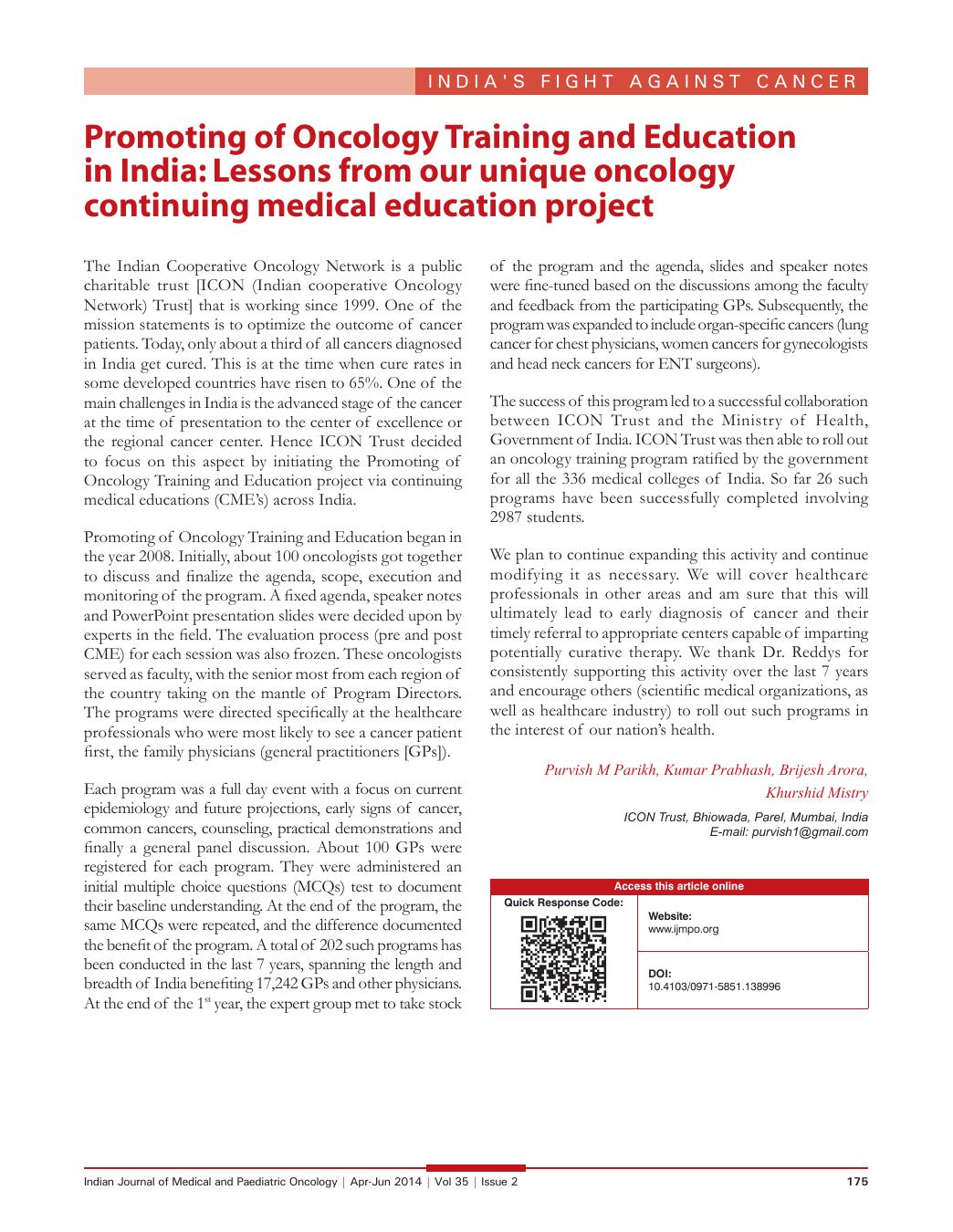Promoting of Oncology Training and Education in India: Lessons from our unique oncology continuing medical education project
CC BY-NC-ND 4.0 · Indian J Med Paediatr Oncol 2014; 35(02): 175
DOI: DOI: 10.4103/0971-5851.138996

|
Publication History
Article published online:
19 July 2021
© 2014. Indian Society of Medical and Paediatric Oncology. This is an open access article published by Thieme under the terms of the Creative Commons Attribution-NonDerivative-NonCommercial-License, permitting copying and reproduction so long as the original work is given appropriate credit. Contents may not be used for commercial purposes, or adapted, remixed, transformed or built upon. (https://creativecommons.org/licenses/by-nc-nd/4.0/.)
Thieme Medical and Scientific Publishers Pvt. Ltd.
A-12, 2nd Floor, Sector 2, Noida-201301 UP, India
References
- Sharma S, Mishra K, Agarwal S, Khanna G. Solid tumors of childhood. Indian J Pediatr 2004;71:501-4.
- Lanier AP, Holck P, Ehrsam Day G, Key C. Childhood cancer among Alaska Natives. Pediatrics 2003;112:e396.
- Kusumakumary P, Jacob R, Jothirmayi R, Nair MK. Profile of pediatric malignancies: A ten year study. Indian Pediatr 2000;37:1234-8.
- Fajardo-Gutiérrez A, Juárez-Ocaña S, González-Miranda G, Palma-Padilla V, Carreón-Cruz R, Ortega-Alvárez MC, et al. Incidence of cancer in children residing in ten jurisdictions of the Mexican Republic: Importance of the Cancer registry (a population-based study). BMC Cancer 2007;7:68.
- Steliarova-Foucher E, Stiller C, Lacour B, Kaatsch P. International Classification of Childhood Cancer, third edition. Cancer 2005;103:1457-67.
- Maitra A. Diseases of infancy and childhood. In: Kumar V, Abbas AK, Fausto N, Aster JC, editors. Robbins and Cotran Pathologic Basis of Disease. 8 th ed. Pennsylvania: Saunders; 2010. p. 447-83.
- Hicks J, Mierau GW. The spectrum of pediatric tumors in infancy, childhood, and adolescence: A comprehensive review with emphasis on special techniques in diagnosis. Ultrastruct Pathol 2005;29:175-202.
- Mamatha HS, Kumari BA, Appaji L, Attili SV, Padma D, Vidya J. Profile of infantile malignancies at tertiary cancer center - A study from south India. J Clin Oncol 2007;25:20026. (Meeting Abstracts).
- Banerjee CK, Walia BN, Pathak IC. Pattern of neoplasms in children. Indian J Pediatr 1986;53:93-7.
- Fischer PR, Ahuka LO, Wood PB, Lucas S. Malignant tumors in children of northeastern Zaire. A comparison of distribution patterns. Clin Pediatr (Phila) 1990;29:95-8.
- Lee CK, Ham EK, Kim KY, Chi JG. A histopathologic study on tumors of childhood and adolescence. J KCRA 1966;1:75-80.
- Malone M. Soft tissue tumours in childhood. Histopathology 1993;23:203-16.
- Kaneda HJ, Mack J, Kasales CJ, Schetter S. Pediatric and adolescent breast masses: A review of pathophysiology, imaging, diagnosis, and treatment. AJR Am J Roentgenol 2013;200:W204-12.
- Bock K, Duda VF, Hadji P, Ramaswamy A, Schulz-Wendtland R, Klose KJ, et al. Pathologic breast conditions in childhood and adolescence: Evaluation by sonographic diagnosis. J Ultrasound Med 2005;24:1347-54.
- Demircan M, Balik E. Pilomatricoma in children: A prospective study. Pediatr Dermatol 1997;14:430-2.
- Linabery AM, Ross JA. Trends in childhood cancer incidence in the U.S. (1992-2004). Cancer 2008;112:416-32.
- Ljungman G, Jakobson A, Behrendtz M, Ek T, Friberg LG, Hjalmars U, et al. Incidence and survival analyses in children with solid tumours diagnosed in Sweden between 1983 and 2007. Acta Paediatr 2011;100:750-7.
- Eyre R, Feltbower RG, Mubwandarikwa E, Jenkinson HC, Parkes S, Birch JM, et al. Incidence and survival of childhood bone cancer in northern England and the West Midlands, 1981-2002. Br J Cancer 2009;100:188-93.
- McNally RJ, Kelsey AM, Cairns DP, Taylor GM, Eden OB, Birch JM. Temporal increases in the incidence of childhood solid tumors seen in Northwest England (1954-1998) are likely to be real. Cancer 2001;92:1967-76.
- Parham DM, Ellison DA. Rhabdomyosarcomas in adults and children: An update. Arch Pathol Lab Med 2006;130:1454-65.
- Kachanov DY, Dobrenkov KV, Abdullaev RT, Shamanskaya TV, Varfolomeeva SR. Incidence and survival of pediatric soft tissue sarcomas in moscow region, Russian Federation, 2000-2009. Sarcoma 2012;2012:350806.
- Toma P, Granata C, Rossi A, Garaventa A. Multimodality imaging of Hodgkin disease and non-Hodgkin lymphomas in children. Radiographics 2007;27:1335-54.
- Madhavan J, Ganesh A, Roy J, Biswas J, Kumaramanickavel G. The relationship between tumor cell differentiation and age at diagnosis in retinoblastoma. J Pediatr Ophthalmol Strabismus 2008;45:22-5.
- Ueno T, Tanaka YO, Nagata M, Tsunoda H, Anno I, Ishikawa S, et al. Spectrum of germ cell tumors: From head to toe. Radiographics 2004;24:387-404.
- Gatta G, Capocaccia R, Stiller C, Kaatsch P, Berrino F, Terenziani M, et al. Childhood cancer survival trends in Europe: A EUROCARE Working Group study. J Clin Oncol 2005;23:3742-51.


 PDF
PDF  Views
Views  Share
Share

